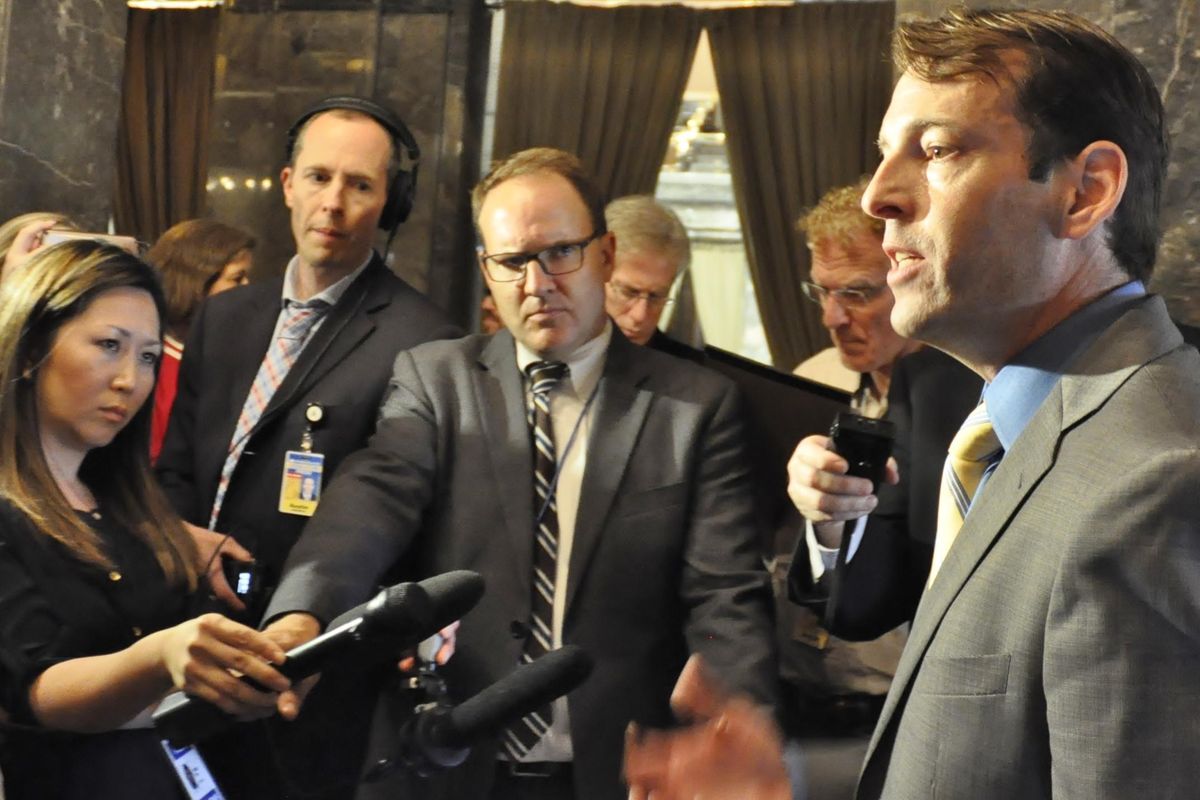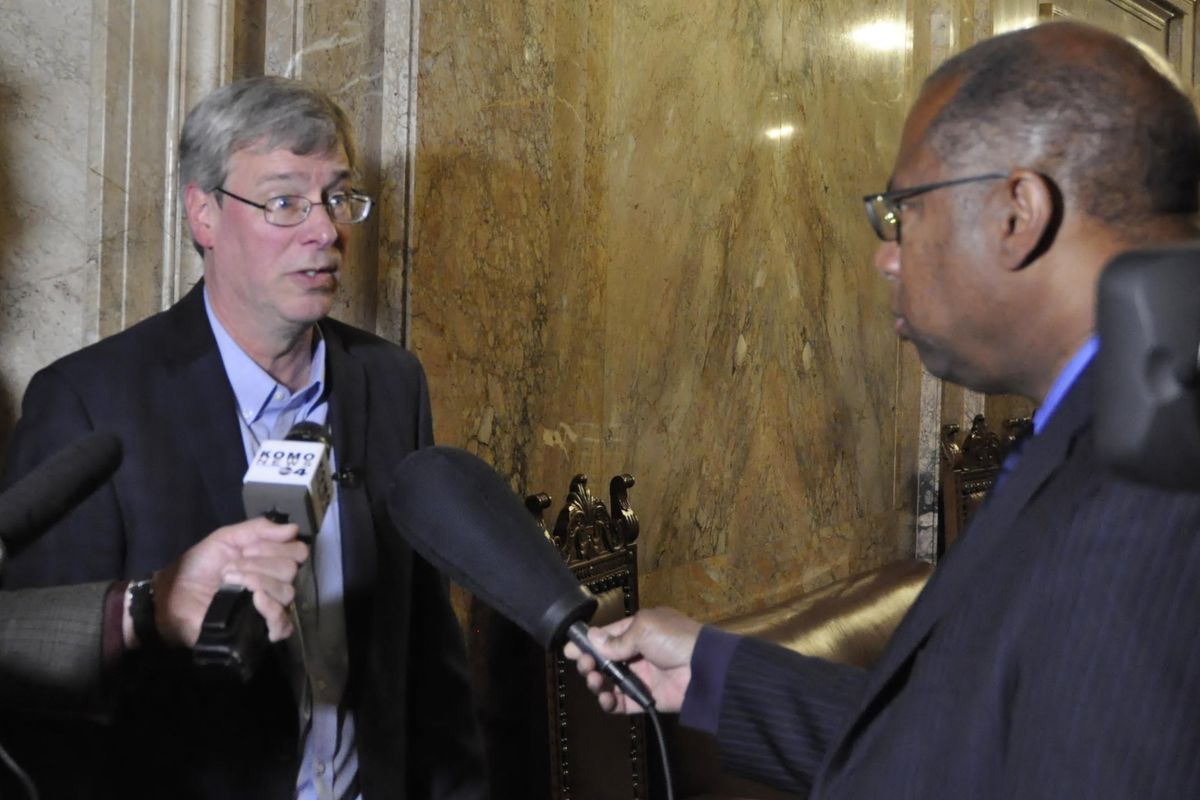What’s in Washington 2017-19 budget deal? Public might not see until Friday morning
OLYMPIA – House Majority Leader Pat Sullivan tells reporters a deal “in principle” on the state’s 2017-19 operating budget was reached early Wednesday morning but details won’t be released until Thursday. (Jim Camden / The Spokesman-Review)
4:40 p.m. Update: Washington would spend a record amount on government programs and salaries in the next two years, adding to current revenue with a major shift in property taxes, collecting sales tax on internet sales and several other tax changes.
Full details of the budget and the tax package to support it probably won’t be available until Friday morning, but legislators who helped negotiate the many compromises over the two-year spending plan briefed reporters on some of aspects Thursday afternoon.
It is a budget that really strongly supports Democratic values, funded by a Republican revenue plan,” Sen. Kevin Ranker, D-Orcas Island, said.
Key to the changes in education policy are a change in the state and local property tax system described below.
Republicans described the changes as a way to even out property taxes across the state, while bringing more equality to what the state contributes for each public school student.
Some Democrats criticized the property tax as more regressive than other options that had been considered.
“There are some winners and some losers with the property tax,” Ranker said. Overall, Democrats were willing to compromise because the budget has programs they support, although some members of both parties in the House and Senate are likely to vote against the budget when it comes to the floor Friday.
“I am confident we have the votes to pass it,” he said.
The state will also try to collect sales tax from internet vendors located out of state for items purchased by Washington residents. Bottled water sold in Washington stores will be subject to the sales tax; right now its exempt as a food item.
3:45 p.m. Update: The budget deal reached by legislative leaders is being described as one that supports Democratic values with a Republican tax system.
The compromise was necessary, several lawmakers said, to reach an agreement on a generational change in the state’s public school system.
The largest element of the proposal is a major shift in the property tax levy system, increasing the state levy to $2.70 per every $1,000 of assessed value, up from $1.88. At the same time, it would limit the amount a local school district can levy to $1.50 per $1,000 of property values.
When the two are combined on a property owner’s tax statement, some will see decreases and others increases. That’s because school district levies vary widely across the state, with some poor rural districts levying several times that $1.50 limit and some fast-growing urban areas levying much less.
Full details of the budget, the revenue package that supports it and the major rewrite of school funding may not be available until Friday morning. But members of both parties praised the compromise over school policy even though some said they believed there were better ways to pay for it.
Sen. Andy Billig, D-Spokane, a member of the group that negotiated the changes to education, predicted the bill, if it passes, will meet the Washington Supreme Court mandate to improve schools. It was driven by a desire on all sides to help all students in the state reach their highest potential.
“In 20 years, people will look back and say we closed the opportunity gap,” Billig said.
Sen. Ann Rivers, R-Vancouver, another member of the education task force, said it will solve problems that have been “festering” for 30 years.
“No longer will a child’s education be determined by their ZIPcode,” Rivers said.
2:25 p.m. Update: Washington would spend an extra $7.3 billion on public schools over the next four years under a major upgrade to education that would be part of the deal over the operating budget.
The changes to education, designed to meet a Washington Supreme Court mandate, call for increased salaries for teachers and other school staff, starting at $40,000 a year, with regional adjustments to recognize different living costs around the state.
It would also spent nearly $200 million over the net four years to reduce the number of students in middle and high school classes. Local districts’ property tax levies would be limited to “enrichment”, or things not determined to be basic education, which will be covered by the state.
1 p.m. Update: Lawmakers came out of caucus meetings after being briefed on the budget with instructions to return in about an hour to begin voting on some bill needed to make the budget work, but not the budget itself. And not the biggest piece of it, the major change in public school policy designed to meet a Washington Supreme Court mandate.
Those won’t come to a vote until Friday, the last day of the fiscal year and the day when a budget must be passed and signed to prevent a partial shutdown of state government services and temporary layoff of about 32,000 employees.
To accomplish that, legislators will have to cut it closer than ever before. Two years ago, when Gov. Jay Inslee signed the operating budget just 20 minutes before midnight on June 30, the Legislature approved the budget on June 29, giving Inslee’s staff time to review the massive document while lawmakers worked on passing policies the budget contained.
This year it’s possible the public won’t see the budget before Friday morning as legislative staff scramble to assemble it, check wording and figures and put it in a form that can be introduced in the Legislature and posted online.
Some lawmakers involved in negotiations over the education policy tentatively scheduled a briefing on those changes for sometime Thursday afternoon.
10:30 a.m. Update: Legislative leaders began briefing their members at 10 a.m. Thursday but it was unclear when the public would see any information about the budget deal, or it’s most significant element involving improvements to the public school system. A complete budget is not expected to be compiled, proofread and printed before Thursday evening.
It won’t be posted online and released to the public until then. That schedule also makes it likely both chambers will be voting on it Friday to prevent a partial government shutdown.
A press briefing on the proposed school policy changes is expected in the early afternoon, with an overview of the budget sometime later in the day.
Check back for updates as the day continues.
OLYMPIA – The budget deal reached in the early morning hours Wednesday apparently will stave off a partial government shutdown.
It definitely will spend a record amount of money on key state services, almost certainly will raise some existing taxes or require some new ones, and could satisfy a Washington Supreme Court mandate to improve the state’s public schools. Voters won’t automatically get a chance to reject any tax increase in November.
But if, as predicted, the Legislature manages to pass it by sometime Friday, allowing Gov. Jay Inslee to sign it before midnight, it will keep all phases of state government operating as a new fiscal year starts Saturday.
At that point, the public will have had about a day and a half to find out what’s in the deal, and almost no opportunity to weigh in on whether they think it’s good or bad.
If typical, the 2017-19 operating budget will be at least 570 pages long. That’s the length of earlier versions passed by each chamber in late March, and budgets rarely get shorter as compromises are made.
The Senate proposed spending $43.3 billion over the next two years – and the House $44.8 billion – on programs and salaries ranging from prisons to state hospitals, child welfare to senior services, parks and public lands, and education services ranging from early childhood to medical schools. Both top the current budget total for 2015-17 of $38.2 billion, which is the highest in state history.
The budget agreement reached “in principle” by negotiators early Wednesday morning is somewhere between the Senate and House numbers. The current projections for money the state will collect from existing tax systems and fees won’t cover it. Taxpayers will find out who will pay more sometime Thursday after legislative leaders explain the deal to their members, starting at 10 a.m.
Legislative leaders defended the delay of more than a day in releasing information about the budget. It was necessary for staff to go through the agreement, checking for mistakes and making sure that dollar amounts add up, and to fix any problems they find before it’s printed, Senate Majority Leader Mark Schoesler, R-Ritzville, said.
Lawmakers should see it before anyone else because “the members are the ones that have to make the decision,” he said Wednesday morning a few hours after negotiators reached the deal.
House Majority Leader Pat Sullivan, D-Covington, said in a separate briefing he expected the budget and the education plan will be released around noon Thursday.
“This is not an ideal situation,” Sullivan acknowledged.
Legislative leaders were tight-lipped about the details of the budget and the proposed changes to Washington’s public school system, which Schoesler called a generational change in education.
The changes have been so contentious that a special task force set up last year to make a recommendation on education policy couldn’t reach an agreement. Negotiations involving members of both parties from both chambers wrapped up at the same time as the budget deal.
Public schools make up about half of the operating budget. Although the total amount of spending in the budget won’t be released until Thursday, increases for education, coupled with state employee contracts negotiated last year and increased demand for services are expected to require at least some increase in existing taxes or money from new ones.
The budget proposal does not include a requirement that any tax increases be subject to voter approval in November, Sullivan said. That was a feature of the Senate Republican budget that passed in late March and a major sticking point for House Democrats.
After a total of 174 days in regular and special sessions, lawmakers will have less than a day and a half to pass the budget with majorities in both chambers and get it to the governor’s desk before midnight Friday, the end of the state’s fiscal year and the time when a partial state government shutdown would begin.
The Legislature has never come this close to that fiscal deadline without releasing at least some key points of an operating budget for the coming two years. But Schoesler and Sullivan were both confident that state services covered by the budget would continue without interruption.
The budget will pass with bipartisan majorities, Schoesler predicted, adding he’s “as certain as any human being could be” that a shutdown won’t occur.
Whether lawmakers will need more time to pass other bills needed to make the budget work, and wrap up other issues that at least some view as crucial, is uncertain. Two years ago, the Legislature passed the 2015-17 operating budget late on June 30 and Inslee signed it just 20 minutes before midnight.
They remained in session another 10 days to debate and pass the remaining bills.


